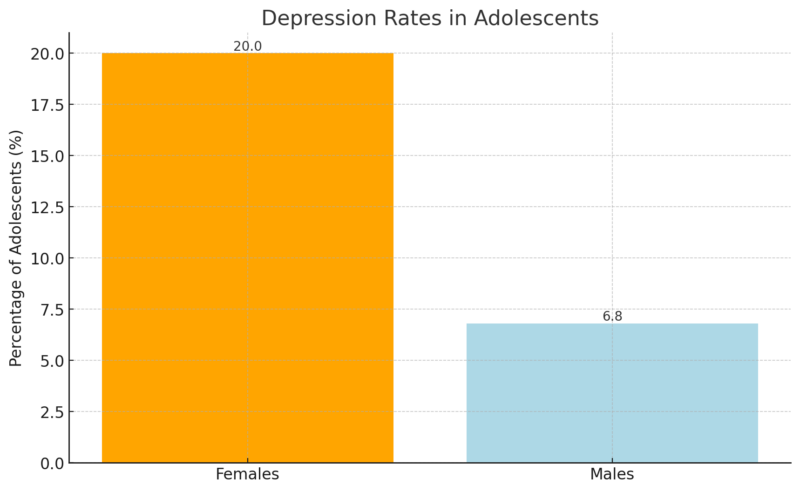Teen mental health is a growing concern, with significant challenges affecting this age group. About 1 in 5 teens experience a mental health disorder each year, making it a widespread issue.
Anxiety disorders are especially common, with nearly 1 in 3 teens being diagnosed.
Depression, too, impacts many adolescents—around 1 in 8, with girls being more affected than boys. Tragically, suicide is the second leading cause of death for teens aged 15-19, underscoring the need for early intervention and support.
The rise of social media has been linked to higher rates of depression, anxiety, and sleep problems, further complicating the mental health landscape for teens.
With half of all mental illnesses starting by age 14, addressing these issues early is critical. Mental health problems also lead to chronic absenteeism, affecting academic performance and overall well-being.
Unfortunately, 60% of teens with depression don’t receive the care they need, highlighting significant gaps in access to mental health services. Addressing these challenges requires both societal attention and improved support systems for adolescents.
Table of Contents
ToggleTLDR
- 1 in 5 teens have a mental health disorder each year.
- 1 in 3 teens have an anxiety disorder.
- 1 in 8 teens experience major depression; higher rates in girls (1 in 5) than boys (1 in 15).
- Suicide is the 2nd leading cause of death for teens aged 15-19.
- Social media use is linked to more depression, anxiety, and sleep issues.
- Half of mental illnesses start by age 14.
- Mental health issues cause school absenteeism, hurting grades and well-being.
- 60% of depressed teens don’t get treatment.
1. High Prevalence of Mental Health Issues
At least 1 in 7 adolescents suffer from a mental disorder, with particularly high rates of depression & anxiety.
👉 @WHO appeals for much greater investment to help almost 1.3 billion teenagers around the world.https://t.co/MNwind8y2e #MentalHealth pic.twitter.com/G1KWMCNyg9
— United Nations Geneva (@UNGeneva) September 26, 2024
Approximately 20% of adolescents experience a mental health disorder each year as per NCBI study shows.
This translates to about 1 in 5 teens dealing with a diagnosable mental health issue, indicating a widespread and significant public health concern among this age group.
2. Anxiety Disorders

Panic Disorder
Characterized by frequent, unexpected panic attacks—sudden episodes of intense fear without clear triggers. Symptoms include a racing heart, chest pain, sweating, and a sense of impending doom. Those with panic disorder may avoid situations that could trigger future attacks.
Social Anxiety Disorder
This involves a deep fear of social situations due to the fear of being judged. Symptoms include blushing, trembling, and avoiding eye contact. It can interfere with daily activities like attending school or work according to NIMH study.
Phobia-Related Disorders
Phobias involve an intense fear of specific objects or situations, such as flying or animals, which lead to avoidance behaviors. Agoraphobia and separation anxiety are other types of phobias, with fears linked to public spaces or being away from loved ones.
Risk Factors
Genetic and environmental factors, childhood shyness, exposure to stressful events, and family history can increase the likelihood of developing an anxiety disorder. Certain health conditions and substances can also trigger or worsen symptoms.
3. Depression Rates

Major depressive episodes affect about 13.3% of adolescents, with higher rates observed in females (20%) compared to males (6.8%).
This gender disparity highlights the need for gender-specific approaches to mental health care and support.
4. Suicide as a Leading Cause of Death
- Suicide is the second leading cause of death among adolescents aged 15-19 years.
- This underscores the critical need for early intervention and support.
Between 2016 and 2019, emergency department (ED) visits for mental health diagnoses increased for those aged 0-17, rising from 784.1 per 100,000 people to 869.3 per 100,000 as per the results of this research. Although the rate dipped slightly in 2019, it peaked at 976.8 per 100,000 in 2018, representing a 25% increase from 2016.
From 2008 to 2020, suicide death rates for individuals aged 12 and older rose by 16%, increasing from 14.0 per 100,000 people to 16.3 per 100,000. Specifically, for youths aged 12-17, the rate climbed from 3.7 per 100,000 to 6.3 per 100,000.
Between 2018 and 2020, the suicide death rate for Hispanic youths increased by 2%, from 4.9 per 100,000 to 5.0 per 100,000. In contrast, the rate for non-Hispanic White youths decreased by 13%, falling from 8.5 per 100,000 to 7.4 per 100,000 according to CDC report.
5. Impact of Social Media

Studies suggest that heavy use of social media is associated with increased risks of depression, anxiety, and sleep problems among adolescents.
The pervasive use of social media platforms among teens necessitates further research and the development of guidelines to mitigate these risks.
Social media usage has been linked to increased feelings of anxiety and depression, particularly among teens and young adults.
The addictive nature of these platforms triggers the brain’s reward system by releasing dopamine when users receive likes and interactions, creating a temporary boost in mood. However, when this validation is absent, it can negatively impact self-esteem.
The use of filters on platforms like Instagram, Snapchat, and TikTok further compounds this issue, as users are exposed to unrealistic beauty standards. Constantly seeing edited images can lead to dissatisfaction with one’s appearance and contribute to body image issues.
The University of California notes that social media fosters a culture of comparison, often referred to as FOMO (Fear of Missing Out). Viewing the “highlight reels” of others’ lives can cause individuals to feel inadequate, leading to lower self-esteem and increased anxiety.
Another serious concern is cyberbullying, with 44% of U.S. internet users reporting online harassment in 2020. Social media platforms are frequent arenas for bullying, spreading rumors, and abuse, all of which can leave lasting emotional damage.
Issue
Impact
Dopamine release
Social media triggers dopamine, causing short-term pleasure but negative effects if approval is absent.
Filters and body image
Altered images can create unrealistic standards, leading to self-consciousness and dissatisfaction.
FOMO
Constant comparison to others’ “highlight reels” increases anxiety and decreases self-esteem.
Cyberbullying
44% of internet users experience harassment, which can severely impact mental health.
6. Early Onset of Symptoms
- Nearly 50% of all lifetime cases of mental illness begin by age 14.
- This highlights the importance of early identification and treatment.
7. School Absenteeism

Mental disorders are among the most prevalent and disabling conditions affecting children and adolescents.
Data from Sage journal showed that one in seven students had a mental disorder in the previous year, with attention-deficit/hyperactivity disorder (ADHD) and anxiety being the most common.
Students with mental disorders had lower school attendance, missing an average of 11.8 days per year in Years 1–6, 23.1 days in Years 7–10, and 25.8 days in Years 11–12. In contrast, students without mental disorders were absent for an average of 8.3 days (Years 1–6), 10.6 days (Years 7–10), and 12.0 days (Years 11–12).
Among those with a mental disorder, 13.4% of their total absences were due to the disorder itself, with this percentage rising from 8.9% in younger students (Years 1–6) to 16.6% in older students (Years 11–12). Enhancing prevention, early intervention, treatment, and management of mental disorders could lead to significant improvements in school attendance.
8. Access to Mental Health Services

In 2021, only 40.6% of U.S. adolescents with a major depressive episode received treatment in the past year. Among those with severe impairment, the treatment rate was slightly higher at 44.2% according to National Institute of Mental Health
This indicates that a substantial number of adolescents with depression do not receive the necessary care.
Innovative approaches, such as pharmacogenomic testing, are being explored to enhance treatment effectiveness.
For instance, GeneSight test analyzes an individual’s DNA to provide personalized medication recommendations for mental health conditions. This test aims to reduce the trial-and-error process often associated with finding the right medication, potentially improving treatment outcomes for adolescents you can check on www.mindful.care/genesight.
References
- Kessler, R.C., Berglund, P., Demler, O., Jin, R., Merikangas, K.R., & Walters, E.E. (2005). Lifetime prevalence and age-of-onset distributions of DSM-IV disorders in the National Comorbidity Survey Replication. Archives of General Psychiatry, 62(6), 593-602.
- Merikangas, K.R., He, J.P., Burstein, M., Swanson, S.A., Avenevoli, S., Cui, L., Benjet, C., Georgiades, K., & Swendsen, J. (2010). Lifetime prevalence of mental disorders in U.S. adolescents: Results from the National Comorbidity Survey Replication–Adolescent Supplement (NCS-A). Journal of the American Academy of Child & Adolescent Psychiatry, 49(10), 980-989.
- Twenge, J.M., Joiner, T.E., Rogers, M.L., & Martin, G.N. (2018). Increases in depressive symptoms, suicide-related outcomes, and suicide rates among U.S. adolescents after 2010 and links to increased new media screen time. Clinical Psychological Science, 6(1), 3-17.
- Luxton, D.D., June, J.D., & Fairall, J.M. (2012). Social media and suicide: A public health perspective. American Journal of Public Health, 102(S2), S195-S200.
- U.S. Department of Health and Human Services. (2020). Mental Health: A Report of the Surgeon General. National Institute of Mental Health.
-
2022 National Healthcare Quality and Disparities Report [Internet]. Rockville (MD): Agency for Healthcare Research and Quality (US); 2022 Oct. CHILD AND ADOLESCENT MENTAL HEALTH. Available from: https://www.ncbi.nlm.nih.gov/books/NBK587174/








